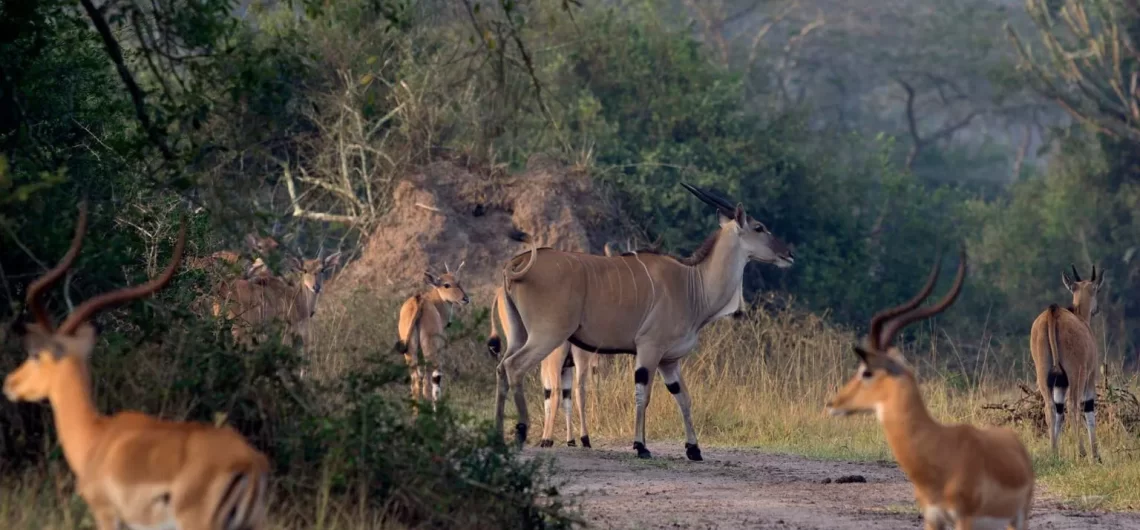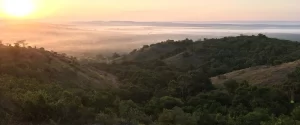A lake dominates the Mburo National Park with forest-fringed shores hemmed in by rolling green hills, scenically reminiscent of the more celebrated Lake Naivasha in Kenya. With its off-the-beaten-path adventures and hidden gems, Lake Mburo National Park is perfect for viewing wildlife on foot. So pull over, wander off, and let chance be your guide. You don’t need a path for adventure; just 100 meters away from just about any trail in Mburo is likely to reveal a magnificent vista not in any guidebook.
Lake Mburo National Park is a small savanna wildlife reserve in southwestern Uganda, an arm’s reach from the capital. It is an excellent stop for long drives to the far southwestern national parks.
The 260 square kilometer park is the only protected area in southwestern Uganda to host zebras and the only park in the country with impalas, slender mongooses, and giant bush rats.
Why go
Mburo is a 4-hour drive from Kampala, Uganda’s most accessible national park. Secondly, due to the absence of the big savannah game players like the elephants and lions, Lake Mburo National Park offers exhilarating walking safari experiences for viewing wild game on foot and horseback.
Even without wildlife heavyweights, this small park offers excellent game viewing. You’re likely to see as many different large mammal species over a day’s visit as you would in any Ugandan national park. In addition, the availability of decent safari lodges and the repopulation of some animals, like giraffes, have raised the park’s profile.
Safari operators promote Lake Mburo National Park as an ideal overnight stop on the long drive between Kampala and the national parks along the country’s western border.
Amazingly, the number of travelers accepting the invitation has risen sharply since exemplary lodges opened up in and just outside the park.
Interesting plant and animal life to watch.
The most prominent feature in the park is the lake Mburo, the largest of five lakes within the park boundaries and part of a cluster of 14 lakes fed by the Rwizi River and connected by several permanent and seasonal swamps.
The other parts of the park mainly feature open savannas and acacia woodland. In the western part of the park, the rocky ridges and forested gorges intersperse with savannas—patches of papyrus swamp and narrow bands of lush riparian woodland line the verges of the various lakes.
Lake Mburo National Park’s commonest wildlife is the impala, the handsome antelope for which Kampala derives its name. You will also see zebra, topi, bushbuck, common duiker, oribi, Defassa waterbuck, and Bohor reedbuck casually feeding on the plain. Also, the lake and lush fringing vegetation support healthy populations of buffalo, warthog, bushpig, and hippopotamus.
A beautiful sight in the park is the large herds of the majestic eland that move seasonally through some parts of the park. Sitatunga is confined to swamp interiors, and you can occasionally observe klipspringer around the rocky areas.
If you lodge in camps or lodges close to the park, you will often hear the eerie rising nocturnal call of the spotted hyena, and many visitors occasionally observe these laughing predators crossing the tracks shortly after dawn.
Leopard, side-striped jackal and various smaller predators are also present in Lake Mburo National Park. Still, you would be fortunate to spot them. In contrast, the most visible small predators are the white-tailed mongoose (visible at dusk and dawn) and three otter species resident in the lakes.
Bird-watching experts have recorded 315 bird species in Lake Mburo National Park. They say the park is the best place in Uganda to see acacia-associated birds.


Comments